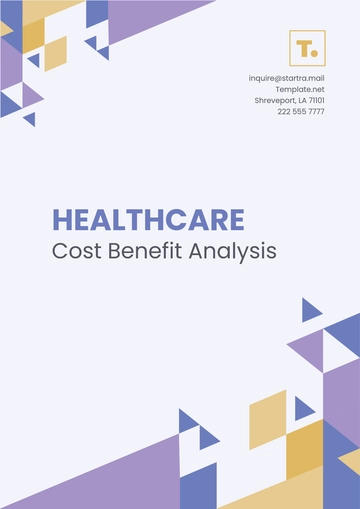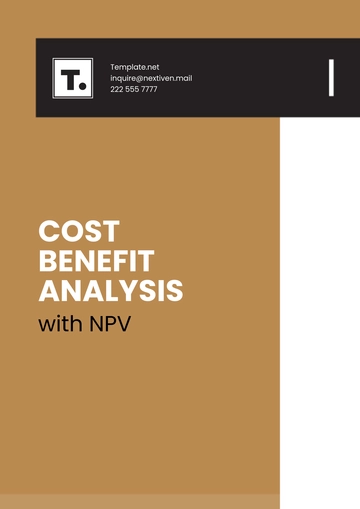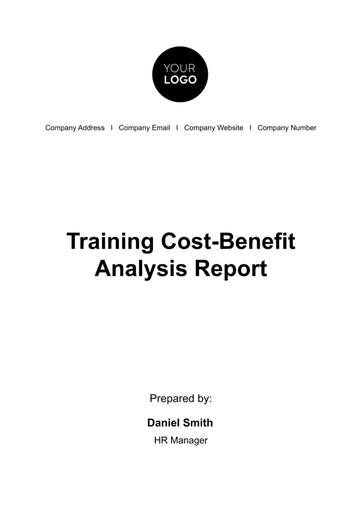Free Travel Agency ROI Analysis

A. Executive Summary
The ROI analysis conducted for [Your Company Name] reveals promising insights into the effectiveness of our investments and strategies. Overall, our initiatives have yielded a commendable return on investment, validating our commitment to maximizing profitability and customer satisfaction.
Key findings indicate that our recent investments in digital marketing campaigns, staff training programs, and enhanced customer service technologies have significantly contributed to revenue growth. Additionally, cost optimization measures have improved operational efficiency, resulting in reduced overhead expenses. Moving forward, recommendations include further leveraging data-driven marketing strategies, enhancing customer engagement initiatives, and exploring strategic partnerships to capitalize on emerging market trends. With a robust ROI of [Insert ROI Percentage], we are well-positioned to continue delivering exceptional travel experiences while driving sustainable business growth.
B. Objectives and Scope
The primary objective of the ROI analysis is to evaluate the financial performance and effectiveness of investments made by [Your Company Name]. This includes assessing the return on investment generated from various operational, marketing, and strategic initiatives undertaken within the specified time frame.
The scope of the analysis encompasses a comprehensive review of key areas such as marketing campaigns, technology upgrades, staff training programs, partnership agreements, and infrastructure enhancements. By examining both the revenue generated and the costs incurred as a result of these investments, the analysis aims to provide actionable insights into the efficacy of our strategies and identify opportunities for optimizing resource allocation and maximizing returns.
C. Investment Overview
Before delving into the specifics of our investments, it's essential to understand the strategic rationale behind each expenditure. This section provides a detailed breakdown of the various investments made by [Your Company Name], shedding light on the initiatives driving our business forward.
1. Marketing Campaigns
[Your Company Name] has allocated significant resources towards targeted marketing campaigns aimed at increasing brand awareness and driving customer acquisition. Investments include digital advertising, social media promotions, email marketing, and search engine optimization (SEO). The total cost incurred for marketing campaigns during the analysis period is outlined below:
Investment Category | Cost |
|---|---|
Digital Advertising | [$X] |
Social Media Promotions | [$X] |
Email Marketing | [$X] |
SEO | [$X] |
2. Technology Upgrades
To enhance operational efficiency and customer experience, [Your Company Name] has invested in upgrading its technological infrastructure. This includes implementing a new booking system, website redesign, and mobile app development. The breakdown of costs associated with technology upgrades is as follows:
Investment Category | Cost |
|---|---|
Booking System | [$X] |
Website Redesign | [$X] |
Mobile App Development | [$X] |
3. Staff Training
Investing in employee training and development is crucial for maintaining high service standards and ensuring staff proficiency. [Your Company Name] has conducted various training programs covering sales techniques, customer service skills, and product knowledge. The total expenditure on staff training initiatives is detailed below:
Investment Category | Cost |
|---|---|
Sales Techniques Training | [$X] |
Customer Service Skills Training | [$X] |
Product Knowledge Training | [$X] |
4. Partnership Agreements
Collaborating with strategic partners allows [Your Company Name] to expand its service offerings and reach new customer segments. Investments in partnership agreements include commission agreements with airlines, hotels, tour operators, and other travel service providers. The investment breakdown for partnership agreements is provided as follows:
Investment Category | Cost |
|---|---|
Airline Partnerships | [$X] |
Hotel Partnerships | [$X] |
Tour Operator Partnerships | [$X] |
5. Infrastructure Improvements
Maintaining and upgrading physical infrastructure is essential for ensuring smooth operations and delivering a seamless customer experience. [Your Company Name] has invested in office renovations, equipment upgrades, and facility enhancements. The cost breakdown for infrastructure improvements is outlined below:
Investment Category | Cost |
|---|---|
Office Renovations | [$X] |
Equipment Upgrades | [$X] |
Facility Enhancements | [$X] |
This comprehensive overview illustrates the diverse range of investments made by [Your Company Name] to support its growth and enhance competitiveness in the travel industry.
D. Revenue Generation Analysis
Understanding the impact of our investments on revenue generation is vital for assessing the effectiveness of our strategies. This section analyzes the sources and trends of revenue generated by [Your Company Name], offering insights into the performance and growth trajectory of our business.
This data represents the total revenue generated by [Your Company Name] over the past five years. You can use this data to create a line graph showing the revenue growth trend over time, providing a visual representation of our agency's financial performance.
E. Cost Analysis
In this section, we delve into a comprehensive examination of the costs incurred by [Your Company Name] in relation to the investments made across various initiatives. By analyzing both direct expenses, such as marketing campaigns and technology upgrades, and indirect costs, including staff time and administrative overhead, we gain valuable insights into the overall financial performance of our agency.
The provided data offers a breakdown of total expenses incurred by [Your Company Name] across various categories. Marketing expenses represent the largest portion at $100,000, followed by technology upgrades at $80,000. Staff training accounts for $50,000, while partnership agreements and infrastructure improvements amount to $70,000 and $60,000, respectively. This analysis highlights the distribution of costs and informs strategic decision-making regarding resource allocation.
F. ROI Calculation
The ROI calculation is essential for evaluating the effectiveness of investments made by [Your Company Name]. It measures the return on investment relative to the total costs incurred, providing a clear indication of profitability and efficiency.
To calculate ROI, we use the following formula:

Where:
Net Profit is the total revenue generated minus the total expenses incurred.
Total Costs include all investments made by the travel agency across various initiatives.
For example, if [Your Company Name] generated a net profit of $300,000 from investments totaling $500,000, the ROI calculation would be:

This means that for every dollar invested, the travel agency generates a return of $0.60, or 60 cents. A positive ROI percentage indicates that the investments are yielding profitable returns, while a negative percentage suggests that the investments are not generating sufficient returns to cover the costs incurred.
G. Recommendations and Future Strategies
The analysis conducted for [Your Company Name] has provided valuable insights into the performance of our investments and areas for improvement. Based on these findings, the following recommendations and future strategies are proposed to optimize ROI and drive sustainable growth:
Enhanced Data Analytics: Invest in advanced data analytics tools to gain deeper insights into customer preferences, behavior patterns, and market trends. Utilize this information to tailor marketing campaigns, personalize customer experiences, and identify untapped opportunities for revenue growth.
Digital Marketing Optimization: Refine digital marketing strategies by focusing on high-return channels and audience segments. Allocate resources effectively across channels such as social media, search engine marketing, and email marketing to maximize reach and engagement while minimizing costs.
Customer Experience Enhancement: Prioritize customer satisfaction and loyalty through exceptional service delivery and personalized experiences. Invest in staff training programs to ensure consistent service standards and cultivate a customer-centric culture throughout the organization.
Strategic Partnerships: Strengthen partnerships with airlines, hotels, and tour operators to expand service offerings and reach new customer segments. Negotiate favorable commission agreements and collaborate on joint marketing initiatives to mutually benefit from increased sales and market exposure.
Operational Efficiency Improvements: Streamline operational processes and eliminate inefficiencies to reduce overhead costs and enhance profitability. Embrace automation and digitalization to improve workflow efficiency, minimize errors, and optimize resource allocation.
Diversification and Expansion: Explore opportunities for diversification by expanding into new markets or offering complementary services such as travel insurance or concierge services. Evaluate potential expansion strategies carefully, considering market demand, competition, and regulatory considerations.
By implementing these recommendations and adopting a proactive approach to strategic planning, [Your Company Name] can position itself for sustained success in the dynamic and competitive travel industry landscape.
In conclusion, the ROI analysis conducted for [Your Company Name] has provided valuable insights into the financial performance of our investments and identified opportunities for optimization. By implementing the recommended strategies and embracing a forward-thinking approach to business development, we are poised to enhance profitability, drive customer satisfaction, and achieve sustainable growth in the dynamic travel industry. We remain committed to delivering exceptional travel experiences while maximizing returns for our stakeholders.
- 100% Customizable, free editor
- Access 1 Million+ Templates, photo’s & graphics
- Download or share as a template
- Click and replace photos, graphics, text, backgrounds
- Resize, crop, AI write & more
- Access advanced editor
Optimize your investments with the Travel Agency ROI Analysis Template from Template.net. This editable and customizable template helps you measure the return on investment (ROI) for different aspects of your travel agency's operations. Editable in our Ai Editor Tool, it's designed to analyze the effectiveness of marketing campaigns, the profitability of various travel packages, and the efficiency of operational enhancements.





























